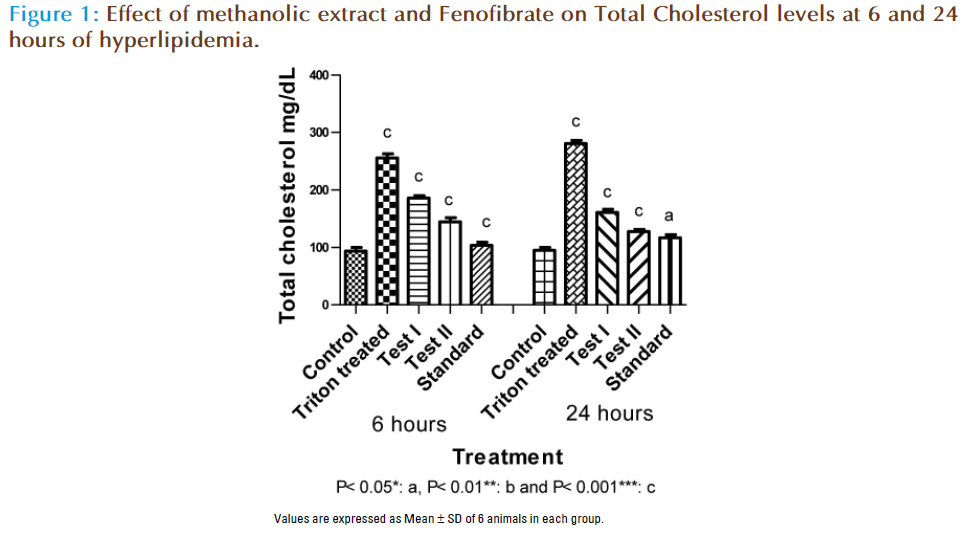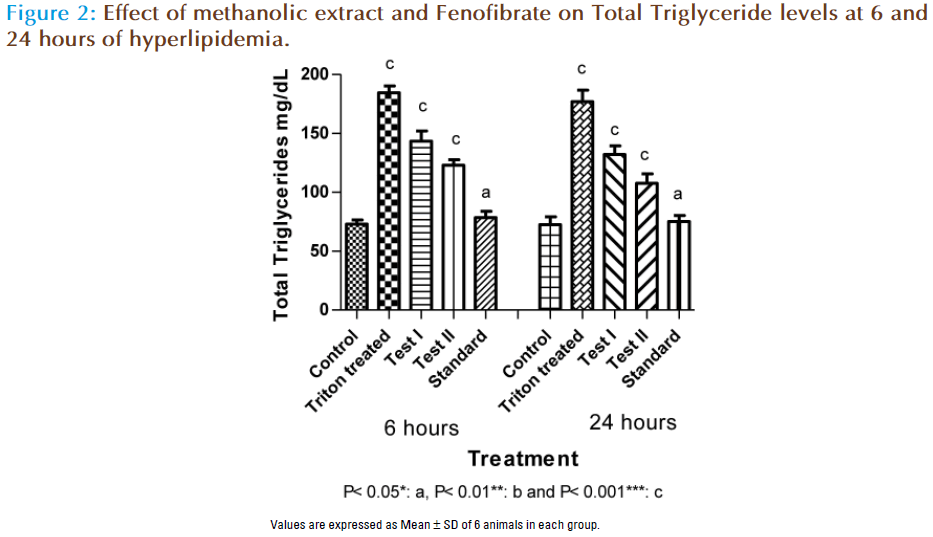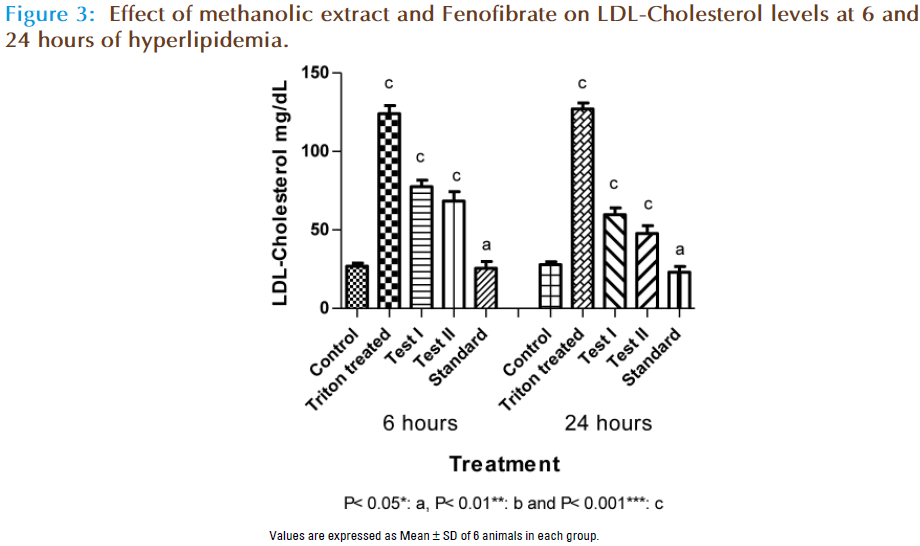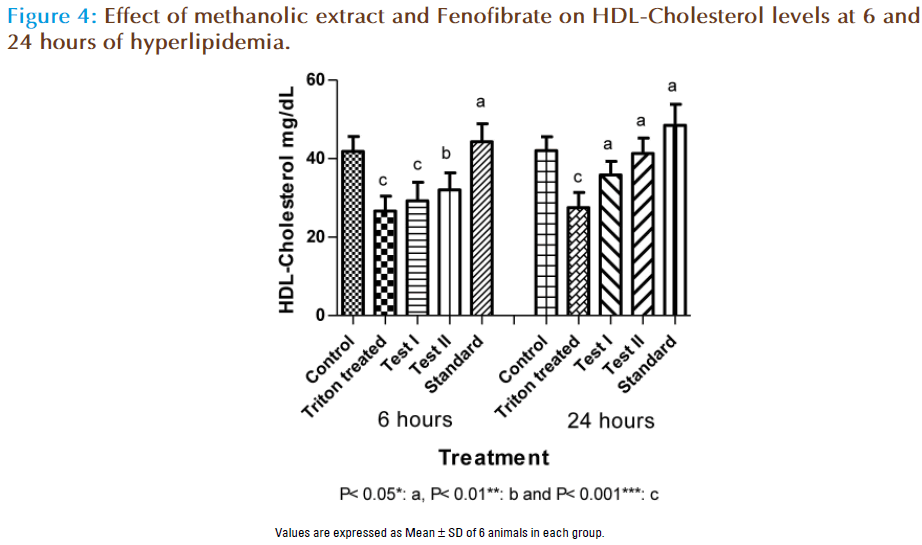Pharmacological Screening of Annona cherimola for Antihyperlipidemic Potential
- *Corresponding Author:
Date of Received: 19-01-2011
Date of Modified: 07-03-2011
Date of Accepted: 10-03-2011
Available Online: 15-05-2011
Abstract
High blood cholesterol levels are consistently associated with higher risk of coronary heart disease, and other life-threatening cardiovascular and cerebro-vascular damage, including fatal strokes. In the present study methanolic extract of Annona cherimola was evaluated for its antihyperlipidemic potential. Acute hyperlipidemia was induced by single administration of Triton WR 1339 (Tyloxapol) intra-peritoneally. There was a significant dose dependent decrease in plasma total cholesterol, triglycerides and LDL-cholesterol at the same time considerable increase in HDL-cholesterol levels upon administration of methanolic extract at the dose of 250 mg/kg and 500 mg/ kg. Fenofibrate was used as reference standard. Atherogenic index as well as LDL/ HDL cholesterol ratio was lowered significantly in case of methanolic extract treated groups compared to normal control which reflects the antihyperlipidemic potential of Annona cherimola.
Keywords
Annona cherimola, Triton WR 1339, atherogenic index and LDL/HDL cholesterol ratio.
Abbreviations
AIP - Atherogenic Index of Plasma
ANOVA - Analysis of Variance
CMC - Carboxy Methyl Cellulose (sodium salt of CMC)
HDL - High Density Lipoprotein
LDL - Low Density Lipoprotein
mg/dL - milligram/ deciliter
mg/kg - milligram/ kilogram
SD - Standard Deviation
WF - vonWillebrand Factor
Introduction
Hyperlipidemia is a state of high lipid profile or high cholesterol levels in the plasma, which can lead to severe health complications like congestive cardiac failure, atherosclerosis and pancreatitis [1]. World Health Organization reports that high plasma cholesterol contributes to approximately 56% of cardiovascular diseases worldwide and causes about 4.4 million deaths each year [2].
Lipid-lowering strategy may have a beneficial role in normalizing vascular function and greatly decreasing the frequency of clinical events associated with atherosclerosis, combined with the ability of antioxidants to alleviate vasomotor disturbances in hypercholesterolemia and to slow the progression of atherosclerosis [3]. Studies on atherosclerosis reveal the probability that the disease may be due to free radical reactions involving diet-derived lipids in the arterial wall and serum to yield peroxides and other substances. These compounds induce endothelial cell injury and produce changes in the arterial walls [4]. Free radicals may contribute to atherogenesis by oxidizing low density lipoproteins (LDLs) which then damage arterial walls. The oxidation of LDL cholesterol is suspected to occur at the initial stages of atherosclerosis, and vitamin E has been shown to inhibit this oxidative reaction [5]. There is evidence that adhesion of monocytes to the endothelium and transformation of macrophages into foam cells, plaque stability, vasomotor function, platelet aggregation and tendency to thrombosis lead to the development of atherosclerosis and coronary artery disease and can be modified by antioxidants [6-7].
Inflammation plays a key role in the development of the atheromatous plaque. Haemostatic factors appear to be involved early in atherogenesis such as factors VII (FVII) and VIII (FVIII), vonWillebrand factor (vWF) and above all elevated levels of fibrinogen [8]. Inflammation is now recognized as an important contributing factor to atherosclerosis and heart disease. Inflammatory molecules stimulate events that lead to the recruitment of white blood cells into the blood vessel wall, where they give rise to abnormal foam cells and initiate the development of atherosclerotic lesions. Inflammation participates in all phases of Atherothrombotic Disease: initial lesion, progression of lesion and thrombotic complications [9].
Thus the desirable medicament must not be confined just to reduce the lipid levels in plasma but also should be efficient to protect from free radical damage and inflammation. There is an increase in interest in finding a plant based compound having both antioxidant as well as anti-inflammatory properties, which could reduce the increased lipid levels in plasma. In our earlier studies methanolic exract of Annona cherimola has showed good antioxidant and anti-inflammatory properties invitro [10]. Therefore we have chosen Annona cherimola to evaluate for antihyperlipidemic activity invivo.
Materials and Methods
Collection of Plant material and Authentication
Annona cherimola belonging to family Annonaceae has been selected for this study. The plant material was collected from Thirumala forest, Chittor district, Andhra Pradesh, India and authenticated by Dr. Madhava Chetty, botanist, Sri Venkateshwara University, Tirupathi. The leaves were shade dried and ground into coarse powder.
Chemicals
Tyloxapol or Triton WR-1339 (a non-ionic detergent, iso octyl polyoxy ethylene phenol, formaldehyde polymer) was purchased from Hi Media, Hyderabad. Finofibrate was purchased from Moral Labs, Chennai. Cholesterol and HDL-Cholesterol enzyme kit purchased from Span Diagnostics Ltd., Triglycerides and LDL-Cholesterol kits from Euro Diagnostic System. All other chemicals were of analytical grade and obtained locally.
Preparation of Extract
500g of powdered leaves of Annona cherimola was extracted continuously using soxhlet apparatus with methanol at 30°C for about 48 hours. The extract was concentrated under reduced pressure using Rotary vacuum flash evaporator to get a constant volume.
Preliminary Phytochemical analysis
The Methanolic exract of Annona cherimola was subjected to preliminary phytochemical screening to identify phytochemical constituents [11].
Experimental Animals
Wister albino adult female rats weighing 120-150g were purchased from National Institute of Nutrition, Hyderabad, India. The animals were grouped and housed in polyacrylic cages and maintained under standard laboratory conditions with dark and light cycle (12:12 hour) and temperature 22±0.5°C. They were allowed free access to standard dry pellet diet (National Institute of Nutrition, Hyderabad, India) and water ad libitum. The rats were acclimatized to laboratory condition for 1 week before commencement of experiment. The experiment was carried out according to the guidelines of the Committee for the Purpose of Control and Supervision of Experiments on Animals and approved by Animal Ethical Committee of Department of Genetics, Osmania University, Hyderabad, India (approval no.380/01/a/CPCSEA).
Antihyperlipidemic Screening
The animals were divided into five groups of six rats each.
I) Normal Control (NC): Received 2% CMC
II) Hyperlipidemic Control (HL): Received 2% CMC + 200 mg /kg Triton WR 1339
III) Hyperlipidemic + Extract (HL + E): Received 200 mg /kg Triton WR 1339 + 250mg/ kg methanolic extract in 2% CMC
IV) Hyperlipidemic + Extract (HL + E): Received 200 mg /kg Triton WR 1339 + 500mg/ kg methanolic extract in 2% CMC.
V) Hyperlipidemic + Standard (HL + STD): Received 200 mg /kg Triton WR 1339 + 65 mg/kg Fenofibrate in 2% CMC.
The animals were administered with methanolic extract (in case of III & IV groups), standard drug Fenofibrate (in case of Group V) and 2% CMC (in case of Group I) for 7 consecutive days through intra gastric tube daily. On the 8th day the animals were fasted for 18 hours (had only access to water) and Triton WR 1339 (200mg/kg) dissolved in normal saline and administered intraperitoneally to all the animals except Normal control (Group I).
Biochemical analysis of Plasma
After 6 and 24hours of Triton WR 1339 injection the blood was collected from Retro-orbital plexus of rats in heparised vials. The blood was centrifuged at 3000 rpm for 10 minutes to separate the plasma. Plasma was analyzed for Total Cholesterol, HDLCholesterol, LDL-Cholesterol and Triglycerides using enzyme kits. The Atherogenic index of plasma (AIP) was calculated for each group of rats by using formula
AIP = Log (Triglycerides/HDL Cholesterol)
Statistical Analysis
Statistical evaluation of data was done by one-way ANOVA followed by Dunnet’s multiple comparison tests using Graph pad prism software version 5.0 and the values were expressed as Mean ± S.D. P values < 0.05 Vs Control group were considered as statistically significant.
Results
Upon single dose (200mg/kg) administration of Triton WR 1339, prominent changes were observed in the lipid profile of experimental animals (Fig 1-4). After 6 and 24 hours of Triton administration the total cholesterol levels were significantly raised from 93.30±6.37 to 255.53±6.91 mg/dL and 95±2.32 to 280.5±5.30 mg/dL respectively. Total triglycerides levels were also elevated from 73.06±3.53 to 184.56±5.75 mg/dL and 72.60±6.69 to 176.92±9.82 mg/dL after 6 and 24 hours of Triton application respectively. Similarly LDL-Cholesterol levels amplified from 26.83± 2.13 to 124.00±5.29 mg/dL and 27.83±1.93 to 127.16±3.76 mg/dL respectively after 6 and 24 hours of Triton injection. But HDL-Cholesterol levels were decreased from 41.86±3.81 to 26.60±3.67 mg/dL and 42.05±3.57 to 27.50±3.93 mg/dL after 6 and 24 hours of Triton administration respectively.
Methanolic extract of Annona cherimola at the dose of 250 mg/kg (Group III) significantly reduced the total cholesterol levels by 27.19% and 42.80%, total triglyceride levels by 22.20% and 27.36% and also declined LDL-Cholesterol levels by 37.50% and 53.1% respectively at 6 and 24 hours treatment. At the same time elevated the HDL-Cholesterol levels by 9% and 23.20% at 6 and 24 hours treatment. Methanolic extract at the dose of 500 mg/kg (Group IV) had showed comparatively better effect on lipid profile than Group III, as it ameliorated the total cholesterol levels by 43.49% and 54.46%, total triglyceride levels by 33.31% and 39.10% and also declined LDL-Cholesterol levels by 44.90% and 62.50% at the same time elevated the HDL-Cholesterol levels by 17.0% and 33.46% at 6 and 24 hours treatment respectively.
Atherogenic index of plasma (AIP) was raised alarmingly in Triton treated (Group II) animals compared to normal control (Group I) as shown Table 1. Methanolic extract at 250 mg/kg dose (Group III) lowered the AIP by 17.8% and 30.0% as well as methanolic extract at 500 mg/kg dose (Group IV) by 30.9% and 48.7% at 6 and 24 hours treatment respectively. LDL/HDL-Cholesterol ratio was also markedly elevated upon Triton administration in Group II compared to normal control (Group I) as shown in Table 1. Methanolic extract at 250 mg/kg dose (Group III) lowered the LDL/ HDL ratio by 43.3% and 64.0% as well as methanolic extract at 500 mg/kg dose (Group IV) by 54.2% and 75.1% at 6 and 24 hours treatment respectively. Standard Fenofibrate had shown better prominent effect of all parameters considered when compared to the methanolic extract.
| S.No | Groups | Atherogenic Index | LDL-C/HDL-C | |||
|---|---|---|---|---|---|---|
| 6th hour | 24th hour | 6th hour | 24th hour | |||
| 1 | Group I (Normal control) | 0.24 ± 0.04 | 0.23 ± 0.07 | 0.64 ± 0.09 | 0.66 ± 0.48 | |
| 2 | Group II (Triton treated) | 0.84 ± 0.06c | 0.80 ± 0.06c | 4.66 ± 0.57c | 4.62 ± 0.61c | |
| 3 | Group III (Triton + extract 250mg/kg) | 0.69 ± 0.06c | 0.56 ± 0.05c | 2.64 ± 0.44c | 1.66 ± 0.24c | |
| 4 | Group IV (Triton + extract 500mg/kg) | 0.58 ± 0.06c | 0.41 ± 0.04c | 2.13 ± 0.36c | 1.15 ± 0.20a | |
| 5 | Group V (Triton + Fenofibrate 65mg/kg) | 0.24 ± 0.02a | 0.19 ± 0.05a | 0.57 ± 0.14a | 0.47 ± 0.08a | |
Values expressed as Mean ± SD of six animals. P< 0.05*:a, P< 0.01**:b, P< 0.001***:c.
Table 1: Effect of methanolic extract and Fenofibrate on AIP and LDL-C/HDL-C ratio at 6 hours and 24 hours of hyperlipidemia.
Discussion
Triton WR 1339 is the non-ionic detergent, induces acute hyperlipidemia consisting of two phases. In phase I, cholesterol levels raise 2-3 times within 24 hours of administration. The increased cholesterol levels decreases nearly to control levels within next 24 hours in phase II. The mechanism of the Triton induced hypercholesterolemia in phase I is thought to be due to increased hepatic synthesis of cholesterol through the ability of Triton to interfere with the uptake of plasma lipids by the tissue [12]. Thus our study was designed to test antihyperlipidemic activity of Annona cherimola within 24 hours of Triton WR 1339 administration as it is used only to induce acute but not chronic hyperlipidemia.
There is an inverse relationship between plasma HDL-cholesterol level and coronary heart disease [13]. It was also reported that HDL is the key component in reverse cholesterol transport, which removes excess cholesterol from peripheral tissues for secretion through the liver [14-15]. At the same time, increase in LDL-cholesterol results in increased risk for the development of atherosclerosis [16]. Thus the desirable medicament to treat hyperlipidemia must elevate HDL-cholesterol at the same time should decrease LDL-cholesterol levels simultaneously.
In the present study methanolic extract of Annona cherimola and Fenofibrate have significantly declined the lipid levels except HDL-cholesterol. The results clearly indicate that methanolic extract lowered total cholesterol, triglyceride and LDL-cholesterol levels in a dose dependent manner although the standard Fenofibrate was more potent in ameliorating the same in plasma. HDL-cholesterol levels were increased in methanolic extract treated animals (Group III & IV) compared to Triton treated animals (Group II) which indicates that methanolic extract was successful in restoring the HDL-cholesterol levels to normal.
The association of Triglycerides and HDL-Cholesterol in the simple ratio called Atherogenic Index of Plasma (AIP) theoretically reflects the balance between risk and protective lipoprotein forces. It was already reported that AIP was a strong predictor of myocardial infarction [17]. Several epidemiological and clinical studies have found the LDL-C/HDL-C ratio to be an excellent predictor of HD risk and an excellent monitor for the effectiveness of lipid-lowering therapies. Moreover the LDL-C/HDL-C ratio had more prognostic value than LDL-C or HDL-C alone [18]. Our methanolic extract has successfully and significantly reduced the atherogenic index (AIP) as well as LDL/HDL-cholesterol ratio which indicates its protective effect against cardiovascular diseases.
It was stated that drugs interfering with cholesterol biosynthesis were shown to be active in phase I (i.e. within 24 hours of induction) of Triton induced hyperlipidemia [12]. Thus the methanolic extract may interfere with any step in the cholesterol biosynthesis.
Conclusion
In conclusion, it is quite evident from our results that methanolic extract of Annona cherimola can be considered as a promising natural remedy for hyperlipidemia and these effects may contribute to its antiatherosclerotic activity. However further studies are recommended to trace the active principle responsible and its possible mechanism of action.
Acknowledgement
We sincerely thank Dr. Roja Rani, Genetics department, Osmania University and Dr. Rama Rao, IICT, Hyderabad and also the management of RVS College of Pharmaceutical Sciences, Sulur, Coimbatore, for their support in this research work.
References
- Grundy SM, Cleeman JI, Merz CN, Brewer HB Jr, Clark LT, Hunninghake DB, Pasternak RC, Smith SC Jr, Stone NJ, et al. Implications of recent clinical trials for the National Cholesterol education program adult treatment panel III guidelines. Circulation. 2004; 110(2): 227-239.
- Third report of the National Cholesterol Education Program (NCEP) Expert panel on detection, Evaluation and treatment high blood cholesterol in adults (Adult Treatment Panel III) Final Report, Circulation. 106; 2002: 3143.
- Chiang-Ting Chien; Wei-Tien Chang; Heui-Wen Chen; Tzung-Dau Wang; Shaw-Yih Liou; Tzay-Jinn Chen; Yen-Lin Chang; Yuan-Teh Lee; Su-Ming Hsu, et al. Ascorbate supplement reduces oxidative stress in dyslipidemic patients undergoing apheresis. Arterioscler Thromb Vasc Biol. 2004; 24(6): 1111-1117.
- Harman D. Role of free radicals in aging and disease. Ann NY Acad Sci. 1992; 673:126-141.
- Stephens NG, Parsons A, Schofield PM, Kelly F, Cheeseman K, Mitchinson MJ, et al. Randomized controlled trial of vitamin E in patients with coronary heart disease: Cambridge heart antioxidant study (CHAOS). Lancet. 1996; 347: 781-6.
- Jane A Leopold, Joseph Loscalzo et al. Oxidative enzymopathies and vascular disease. Arterioscler Thromb Vasc Biol. 2005; 25:1332-1340.
- Tom Saldeen, Dayuan Li, Jawahar L Mehta, et al. Differential effects of alpha- and gamma-tocopherol on low-density lipoprotein oxidation, superoxide activity, platelet aggregation and arterial thrombogenesis. J Am Coll Cardiol. 1999; 34:1208-1215.
- Green D, Foiles N, Chan C, Schreiner PJ, Liu K, et al. Elevated fibrinogen levels and subsequent subclinical atherosclerosis: The CARDIA Study. Atherosclerosis. 2009; 202(2): 623–31.
- Libby P. Molecular bases of the acute coronary syndromes. Circulation. 1995; 91: 2844-50.
- Adarsh verma M, Ajay kumar, Kavitha D, Anurag KB, et al. Anti denaturation and antioxidant activities of annona cherimola in-vitro. International Journal of Pharma and Bio Sciences. 2011; 2(2):1-6.
- Kokate CK, Purohit AP, Gokhale SB, eds. Text Book of Pharmacognosy. Nirali Prakashan Publishers, 2007; 37: 106.
- Gerhard Vogel H ed. Drug Discovery and Evaluation: Pharmacological assays, 2. 2002; New York: Springer- Verlag; 1106.
- Farboodniay Jahromi MA, Anil B Ray, Chansouria JPN, et al. Antihyperlipidaemic effect of flavonoids from Pterocarpus marsupium. J Nat Prod. 1993; 56(7): 989-994.
- Linda K Curtiss, David T Valenta, Neil J Hime, Kerry Anne Rey, et al. What is so special about apolipoprotein AI in reverse cholesterol transport? Arterioscler Thromb Vasc Biol. 2006; 26(1):12–19.
- Vedhachalam C, Phu T Duong, Margaret Nickel, David Nguyen, Padmaja Dhanasekaran, Hiroyuki saito, George H Rothblat, Sissel Lund-katz, Michael C Philips, et al. Mechanism of ATP-binding cassette transporter A1-mediated cellular lipid efflux to apolipoprotein A-I and formation of high density lipoprotein particles. J Biol Chem. 2007; 282(34):25123–25130.
- Warnholtz A, Mollnau H, Oelze M, Wendt M, Munzel T, et al. Antioxidants and endothelial dysfunction in hyperlipidemia. Curr Hypertens Rep. 2001; 3: 53-60.
- J. Michael Gaziano, Charles H. Hennekens, Christopher J. O’Donnell, Jan L. Breslow, Julie E. Buring, et al. Fasting triglycerides, high-density lipoprotein, and risk of myocardial infarction. Circulation. 1997; 96(8): 2520–5.
- Sundar Natarajan, Henry Glick, Michael Criqui, David Horowitz, Stuart R Lipsitz, Bruce Kinosian, et al. Cholesterol measures to identify and treat individuals at risk for coronary heart disease. Am J Prev Med. 2003; 25(1): 50–57.





